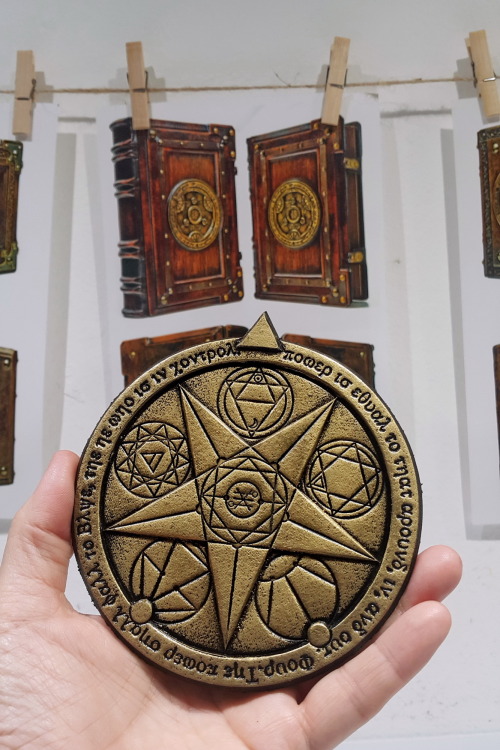#spirits
Join the E-WITCHES Discord Server!
Struggling to find a witchy space you can jump into and feel included? Join our small tight-knit community!
We have tons of resources being uploaded on a regular basis. All inclusive. Safe space. Learn and share your knowledge.. or just join our community of interesting people!
We will be excited to have you here!
XOXO
Join the E-WITCHES Discord Server!
Struggling to find a witchy space you can jump into and feel included? Join our small tight-knit community!
We have tons of resources being uploaded on a regular basis. All inclusive. Safe space. Learn and share your knowledge.. or just join our community of interesting people!
We will be excited to have you here!
XOXO
Join the E-WITCHES Discord Server!
Struggling to find a witchy space you can jump into and feel included? Join our small tight-knit community!
We have tons of resources being uploaded on a regular basis. All inclusive. Safe space. Learn and share your knowledge.. or just join our community of interesting people!
We will be excited to have you here!
XOXO
Join the E-WITCHES Discord Server!
Struggling to find a witchy space you can jump into and feel included? Join our small tight-knit community!
We have tons of resources being uploaded on a regular basis. All inclusive. Safe space. Learn and share your knowledge.. or just join our community of interesting people!
We will be excited to have you here!
XOXO
Join the E-WITCHES Discord Server!
Struggling to find a witchy space you can jump into and feel included? Join our small tight-knit community!
We have tons of resources being uploaded on a regular basis. All inclusive. Safe space. Learn and share your knowledge.. or just join our community of interesting people!
We will be excited to have you here!
XOXO
Building spirit houses and shrines for your household spirits
I believe one of the best way to begin cultivating a relationship with any spirit is to build them a small house or shrine.
Creating a physical space for them in our world begets them allowing us into their spiritual reality.
It’s reciprocity: I will make space for you, and I hope you make space for me.
You don’t need to be able to see or hear spirits, or engage in two-way communication, in order to begin building a relationship with those spirits.
You also do not need to have clearly identified the spirit.
A shrine to a household spirit is very simple. All you need to do is devote a physical space - like a shelf, a box, or even an actual dollhouse - to that spirit.
It is ideal to build the shrine in a place where the spirit seems to spend the most time. If you don’t know where a household spirit likes to spend its time, it is worthwhile to attempt to find out.
Some spirits may like the peace and calm of a cozy little shelf in the pantry. Other spirits may want to be right near the front door or the busiest rooms.
Before you begin building the shrine, inform the spirit of your intent. This does not need to be ceremonial and you do not need to be able to receive messages back from them. Make some general occult fussings - light a candle or incense, ring a bell, rap on walls with your knuckles - you know, stuff that gets their attention.
If you are building a shrine for all spirits in your home, just tell them that. “Everyone, I want us to be friends, so I’m going to make a space for you to rest and enjoy yourselves.”
Perhaps this is for only one spirit. You don’t need to have them fully identified. Try something like this: “I’ve noticed a shy spirit that seems to hide in the bathrooms. I want to make a shrine just for you.”
Trust that you have been heard. In this day and age, oft-neglected spirits are usually delighted that someone is paying attention to them.
Once you’ve told the spirits of your intent, you may begin receiving intuitions. Perhaps you thought one shelf would be best for the shrine, but you keep feeling a nagging sense to build it somewhere else. You may feel feelings of curiosity or excitement that don’t quite seem to be your own.
Use of a pendulum may be of assistance if you’d like to make communication ongoing, but it never does to let divination subsume action.
An appropriate surface, box, or container does not need to be large. Don’t put yourself out by over-spending space. The materials also do not need to be expensive or grandiose. A cardboard shoebox will do. A large quart jar makes a fine spirit shrine. Even an origami box!
What you should try to do is find something with enough space to leave small, delightful objects and gifts. It is a good idea to include a space to leave temporary offerings, even things like glasses of water. For example, you could use an old pickle jar as the primary spirit house, and simply have a dish next to it where you burn incense.
Spirits also sometimes like dark and quiet places. If you are using an open shelf or a clear jar, consider including something with opaque walls, or a divider.
Spirits can move through even the tiniest cracks. A spirit can enter and exit a cardboard box at will, even if the lid is on. Be mindful of sealing jars with airtight lids.
Whatever surface or container you use, ensure it is very clean. I do not mean spiritually cleansed. A pickle jar is fine and well, unless it still smells like pickles. Please remember that many strong scents can be offensive to the spirits.
Also remember that Wortcunning teaches us plants may have specific effects on spirits - your essential oils may just smell nice to you and an infographic may list them as “cleansing”, but their inherent spiritual essences may actually make your spirit home suitable for the wrong kind of spirit, increase manifestations beyond a level you’re comfortable with, or otherwise make the spirit home uncomfortable for the spirit you want to invite there.
Here, less is more - wash, clean, and dust items as you normally would.
The concept with spirit shrines and houses is that the spirits can make actual use of the objects you put there.
Ideally, the spirit home should have comfortable things so the spirits can be cozy and rest.
Gather and place very comfortable, cozy objects on the shrine or in the container. This might be a bit of flannel or a knitted/crocheted swatch for a blanket, a small sewn and stuffed pillow, or even miniature furniture like a dollhouse chair.
These things do not have to be arranged as if they are a diorama bedroom. You can just layer soft fabrics into a box or surface.
Once you have a clean space set aside with a few comfortable objects, and something like an offering dish, the spirit house may be complete.
Make more occult fussings to get the spirit’s attention (although you may sense that the spirit is hovering over your shoulder, so to speak). Tell the spirit that its space is ready. Tell the spirit that it should make use of the space as it pleases. At this time, consider giving a small offering to celebrate the occasion.
However, many other things can be added to the spirit shrine. Be careful when giving non-disposable gifts. Your spirit may very much enjoy its collection of coins and cigarettes, and be upset with you if you need to clear them away because too much space is taken up.
If a spirit is being troublesome around the home, building them a little home may be helpful right away. You can also put things there that they will enjoy playing with. Strings of shiny beads and crystals, windchime charms, colorful tangles of threads, kaleidoscopes (come back and turn them from time to time!), and other colorful, interesting trinkets are often much-beloved by bored household spirits.
You do not need to constantly clean the spirit’s space. Consider that the space is like the spirit’s bedroom - they do not necessarily want you invading their space in order to clean it. A quarterly cleaning (perhaps on each solstice and equinox) will suffice. The spirit home should not collect “negative” energies.
You also do not need a regular offering schedule. An offering even once a month will suffice.
Pay attention to any nagging little thoughts that the spirit house ought to change or be moved. Use a pendulum to help confirm these notions.
Stag’s Rules for Responsible Mediumship:
I have a lot of opinions about what it takes to be a responsible medium. I’ve seen a lot of irresponsible mediumship, and it’s so common that I no longer feel comfortable offering my own mediumship. I now refuse to offer mediumship services, despite offering them years ago.
These are my personal rules for my own mediumship skills, and I’ll admit, the rubric by which I assess other mediums. I’ve set them up in a series of Do’s and Don’ts + some explanations/ reasonings for each.
1.Do: Ask permission before reading, channeling, for relaying messages for anyone.
Don’t: Read, channel, or relay messages for someone unsolicited.
- This should be obvious. Give people a chance to accept or deny your services. We should all understand consent.
2.Do: Help people who express having a problem and ask for help or mediumship.
Don’t: Try to help someone who hasn’t asked for help.
- Not everyone who says they are having trouble with something wants external help. They may want to figure it out themselves.
3.Do: Take responsibility for what you read, channel, or relay.
Don’t: Pass the buck for your reading, channeling, or messages to the entity.
- It’s like being the person at the D&D table who makes wild choices and then justifies it as “That’s what my character would do.” No one like “That Guy” don’t be the occult version of “That Guy.”
4.Do: Encourage people to vet your readings, channeling,or messages with their own divination or outside sources.
Don’t: Expect, or worse insist, others to rely on you and you alone for their knowledge and gnosis.
- As a medium you should want what you say to be backed up by other sources, either academic or community based. This proves that you’re not just making things up or presenting your UPG as fact.
5.Do: Encourage others to develop their own skills, and help/offer advice if asked.
Don’t: Just do a task for someone else who is struggling with a skill you have so that they don’t have to try.
- This will prevent the people you read for from developing their own skills. As a medium should feel proud when someone says, “I don’t need your services anymore, I can do it myself.” There is a good chance your work was helpful in them getting to where they don’t need you anymore.
6.Do: Relay messages or channel for someone with as little personal filter/interpretation as possible.
Don’t: Insert yourself, your opinions, your UPG, or your personal paradigm into someone else’s spiritual relationship.
- I know this one is hard, and it takes practice to master, but irresponsible mediums will use their mediumship to assert their own understandings and beliefs over others. Not everyone has the same understanding or relationships with incorporeal entities, and as a medium you need to remember that and let whoever you are performing mediumship for make their own informed decisions and interpretations. You wouldn’t set yourself up as an unsolicited intermediary between two physical friends, so don’t do it for a person and an incorporeal entity.
You do not need to be able to achieve two-way spirit communication in order to start developing spiritual relationships
I know why people believe this. Or one of the reasons why. If you want to form a relationship with another human, you communicate to them. You talk to them.
But it is a mistake to put that expectation on spiritual relationships.
I want to impress upon you guys that so many practitioners do not have clear communication with their spirits or deities! I honestly suspect this is a majority of all practitioners.
Using tools such as pendulums and tarot cards are completely valid forms of communication.
It is so incredibly unnecessary to exhaust yourself trying to establish psychic connections with your spirits.
And I’m really sorry if people have made you to feel that you are not allowed to be friends with spirits unless you can see and hear them.
There are lots of ways to start establishing relationships with spirits if you haven’t (or don’t want to!!) developed psychic senses.
You can build spirit houses and shrines, and invite the spirits to stay near you.
You cay speak, think, or pray (without connotations of worship) to the spirits, even if you can’t hear anything back.
You can start dedicating actions to the spirits. Do you normally trim the hedges and sweep the back porch? Let them know it is for them. “I’m doing this work so the home and garden you live in is beautiful and nice to be in.”
Youdo not have to maintain a strict offering schedule. Try leaving spirits gifts. Fertilizing your plants is an act of offering. Setting a little dinner aside for them is an act of offering. Opening the windows and playing gentle music is an act of offering.
Living your life in a way that respects and honors the presence of the spirits around you is how you start building relationships with them, even if you can’t see them.
One of the most important ways to start building any spiritual relationship is to live in a way that accepts the presence and reality of these spirits.
I promise you, they will see what you are doing, and they will respond to it.
The Strange History and Mystery of the Ouija Board
Does the Ouija Board really communicate with spirits or is it just a harmless game?
The first advertisements started to appear in papers by 1891: “Ouija, the Wonderful Talking Board". The board was described as magical because it answered questions “about the past, present and future with marvelous accuracy”. It’s price was $1.50.The Ouija board (pronounced Wee-ja) is a flat board marked with the letters of the alphabet, numbers 0-9, and the words “yes”, “no”, and “hello”, “goodbye”. The invention of the original design in still unknown.The Ouija board was, at first, regarded as a harmless parlor game. It’s popularity grew out of the strong American 19th century obsession with spiritualism - the belief that the living are able to communicate with the dead.The first patent was granted in 1891 to Elijah J. Bond as the inventor. Bond’s sister-in-law, Helen Peters (who was reportedly a “strong medium”), is credited for naming the board. While using the board, they asked what it should be named. The word “Ouija” was spelled out and when asked what that meant, the board replied, “Good Luck.”To this day, mainstream religions and some occultists have associated the use of the Ouija board with the threat of demonic possession and have cautioned their followers not to use them.Many believe that evil spirits, disguising themselves as deceased friends or family members, can trick the users of the board and unwittingly invite “them” into their homes. To be rid of such hauntings, Ouija “experts” advise either to burn the board or dispose of it in a lake since spirits supposedly cannot cross water.
Post link
In Ras Michael Brown’s African-Atlantic Cultures and the South Carolina Lowcountry Brown wants to talk about the history of the cultural and spiritual practices of African descendants in the American south. To do this, he traces discusses the transport of central, western, and west-central African captives to South Carolina in the seventeenth and eighteenth centuries,finally, lightly touching on the nineteenth and twentieth centuries. Brown explores how these African peoples brought, maintained, and transmitted their understandings of spiritual relationships between the physical land of the living and the spiritual land of the dead, and from there how the notions of the African simbi spirits translated through a particular region of South Carolina.
In Kelly Oliver’s The Colonization of Psychic Space, she constructs and argues for a new theory of subjectivity and individuation—one predicated on a radical forgiveness born of interrelationality and reconciliation between self and culture. Oliver argues that we have neglected to fully explore exactly how sublimation functions in the creation of the self,saying that oppression leads to a unique form of alienation which never fully allows the oppressed to learn to sublimate—to translate their bodily impulses into articulated modes of communication—and so they cannot become a full individual, only ever struggling against their place in society, never fully reconciling with it.
These works are very different, so obviously, to achieve their goals, Brown and Oliver lean on distinct tools,methodologies, and sources. Brown focuses on the techniques of religious studies as he examines a religious history: historiography, anthropology, sociology, and linguistic and narrative analysis. He explores the written records and first person accounts of enslaved peoples and their captors, as well as the contextualizing historical documents of Black liberation theorists who were contemporary to the time frame he discusses. Oliver’s project is one of social psychology, and she explores it through the lenses of Freudian and Lacanian psychoanalysis,social construction theory, Hegelian dialectic, and the works of Franz Fanon. She is looking to build psycho-social analysis that takes both the social and the individual into account, fundamentally asking the question “How do we belong to the social as singular?”
Read the rest of Selfhood, Coloniality, African-Atlantic Religion, and Interrelational CutlureatTechnoccult












